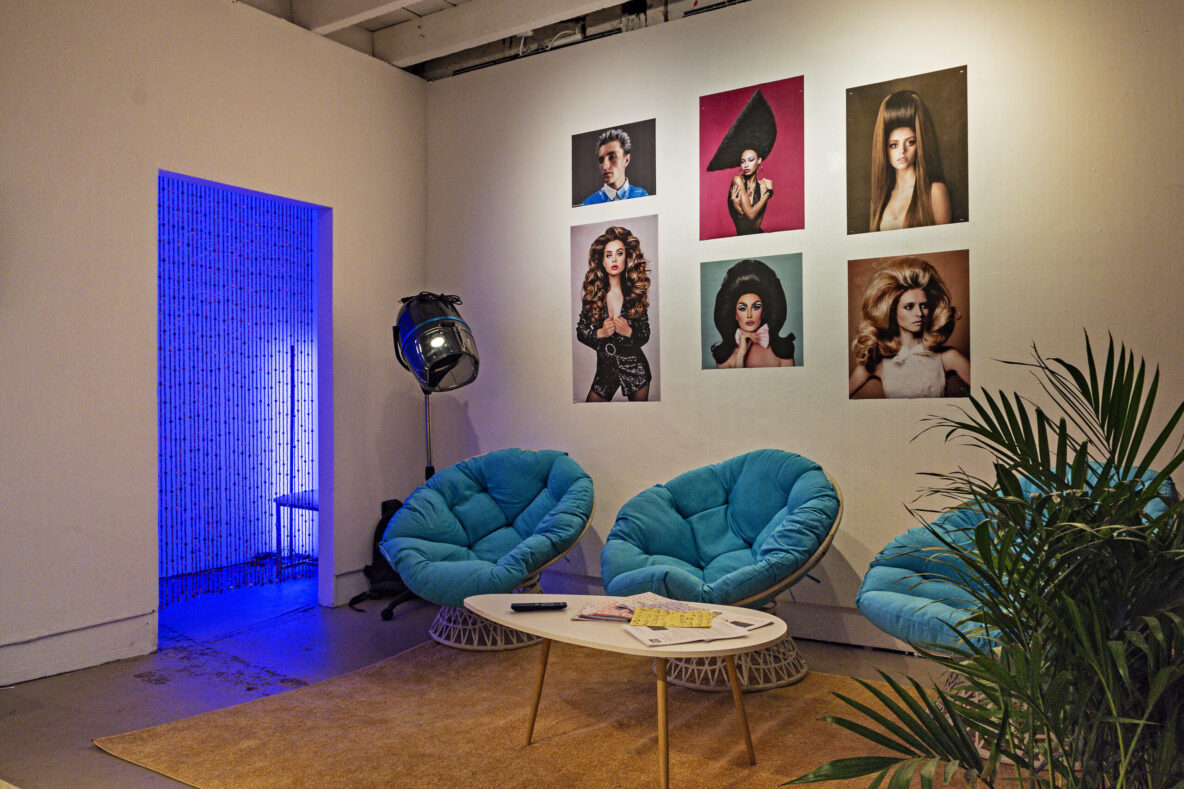Zé Kielwagen, BAFO! Beauty Temple, Open Source Gallery, installation detail, 2024. Photo credit: Stefan Hagen.
Zé Kielwagen is an engaging Brazilian artist who works in and between the fields of sculpture, performance, and video. We met at the opening of his worldbuilding solo exhibition BAFO! Beauty Temple at Open Source Gallery in Brooklyn New York. Zé shares his thoughts and experiences including memory as a collective creation, the contingencies of concrete and material reality, and potential hoe thieves.
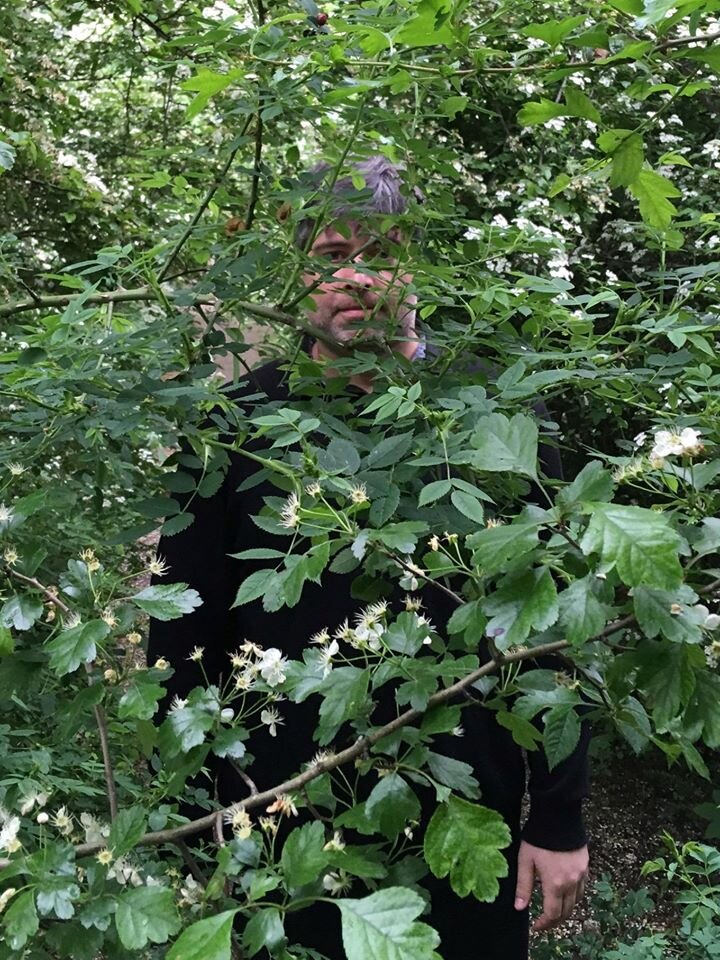 Michele: Your immersive installation BAFO! Beauty Temple is dedicated to honoring the life and imagined afterlife of Baby Bobolete, a beloved Brazilian queer clown and icon created by the late Caike Luna. During the run of the show, you invite visitors to sign up for a free haircut and beauty services in the immerse hair salon, flip through the zine you created for the occasion in the waiting area section, and leave an offering at the alter Exu Bobolete. What was the research like for this project?
Michele: Your immersive installation BAFO! Beauty Temple is dedicated to honoring the life and imagined afterlife of Baby Bobolete, a beloved Brazilian queer clown and icon created by the late Caike Luna. During the run of the show, you invite visitors to sign up for a free haircut and beauty services in the immerse hair salon, flip through the zine you created for the occasion in the waiting area section, and leave an offering at the alter Exu Bobolete. What was the research like for this project?
Zé: For BAFO! Beauty Temple, my main reference was the artist Thomas Hirschhorn’s series of “monuments” dedicated to philosophers, the last and most ambitious being the 2013 site specific and participatory Gramsci Monument, an 8,000 square feet outdoor sculpture on the grounds of a Housing Authority development in the Bronx, New York.
While preparing for this exhibition I read Hirschhorn’s writings and watched his interviews. In one interview on the Gramsci Monument, he said that “it wants to create memory.” I love this idea that a monument, instead of being a structure that embodies and consolidates memories of people and events from the past, is an instance that creates memory by bringing people together, in the present. Memory, in historical terms, is always a collective creation. Hirschhorn’s monuments are also temporary and quite precarious, unlike the stone and bronze statues we often see in public space, created on the premise of some sort of immortality. His monuments are fleeting and dependent on ongoing community engagement. It speaks of the precariousness of memory and the labor that goes into maintaining it. There is something touching, and intensely political about it. I like this very much.
In a way, the BAFO! Beauty Temple at Open Source Gallery is also a monument. A monument to Baby Bobolete, to queer labor and queer workers everywhere. Just like Hirschhorn attempts to reinvent what monuments can be, I am attempting to reinvent temples and shrines.
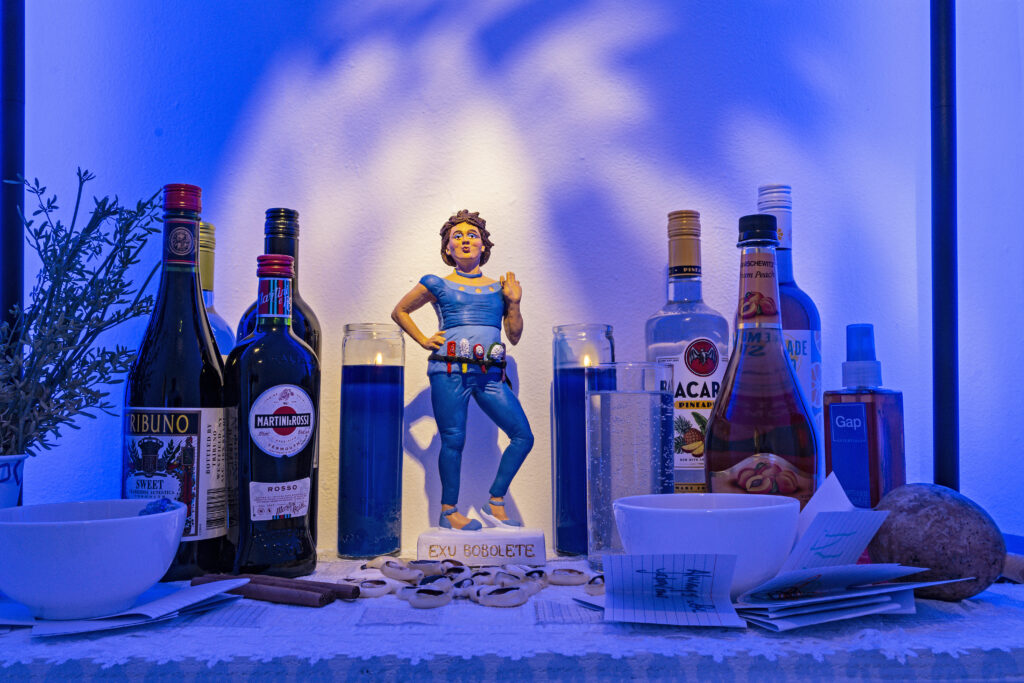
Zé Kielwagen, BAFO! Beauty Temple, Open Source Gallery, Exu Bobolete shrine installation detail, 2024. Photo credit: Stefan Hagen.
Michele: What were the initial concerns when beginning to shape BAFO! Beauty Temple?
Zé: When the decision was made to move forward with the pop-up beauty salon idea I knew I had to assemble a team of beauty workers. That was the first and most important task. Not being a beauty-oriented person, it took a lot of searching and research. I’m the type that only goes to a salon when I absolutely need to. I cut my own hair when I can. I never had my nails done or used any makeup. So, this project led me to venture into an unknown universe. I learned about pay rates, supplies and the different ways beauty workers get by, as freelancers or on contracts with agencies and salons. I had to find these professionals, and persuade them to work in an art gallery, presenting their labor as performance art.
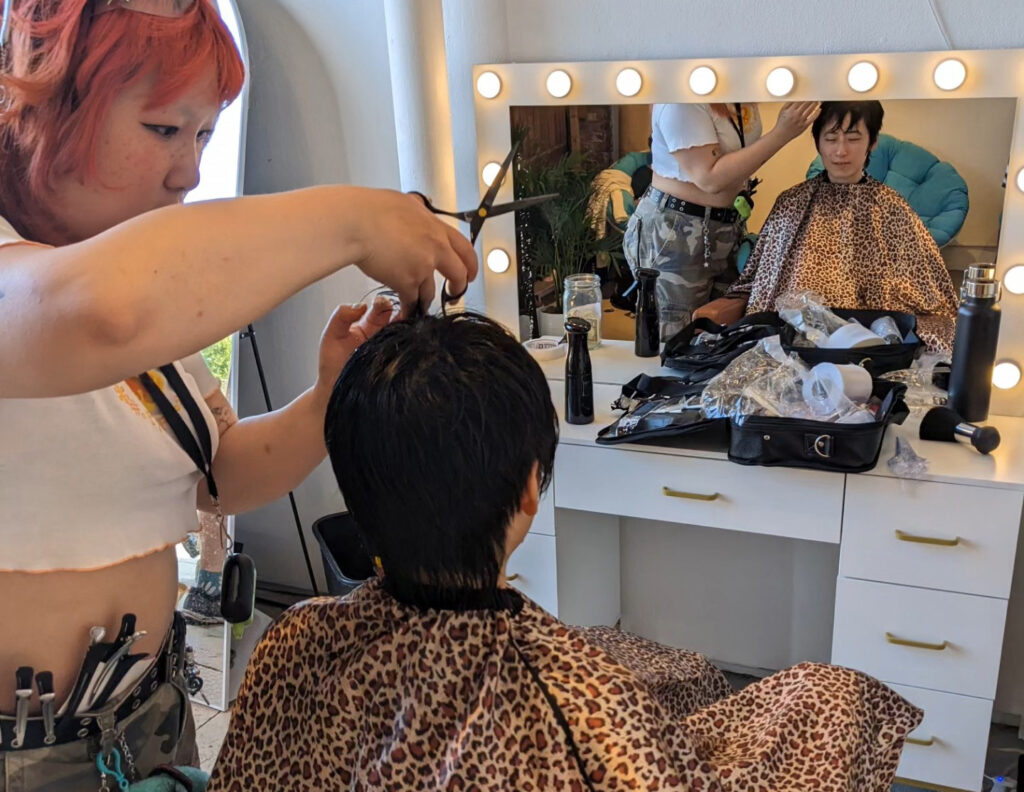
Zé Kielwagen, BAFO! Beauty Temple, Open Source Gallery, installation detail, 2024.
Michele: Share a bit about what drives your public installation work.
Zé: I am mostly driven by intuition and whimsy. It is a personal, affective, and irrational process. Back to Hirschhorn, he claims that his choices of Gramsci, Bataille, Deleuze and Spinoza for his monuments, were motivated by his love for them. Not by the need to educate people about these philosopher´s ideas. The goal is not to provide a service to the public, not to educate, inform and enlighten. Instead, his motives are more personal, and even selfish. Hirschhorn says he loves Gramsci, for example, because he was so dedicated to his mother. As the artist he is entitled to make personal choices. An artist is different from a social worker or an activist. A line has to be drawn somewhere, else art dissolves into other activities and disappears. Hirschhorn locates the artistic impulse in the individual. Which, in a way, winks at a modernist understanding of art as a form of personal expression. Surely he also acknowledges art’s social nature. Art needs to reach out to its public; it is something we do for others. Self-expression as a hobby, or as a form of therapy, is not enough. Everyone has intuition and dreams, and that is effortless. But to invite others in, to allow others to inhabit my dream, takes work. That is the work of the artist.
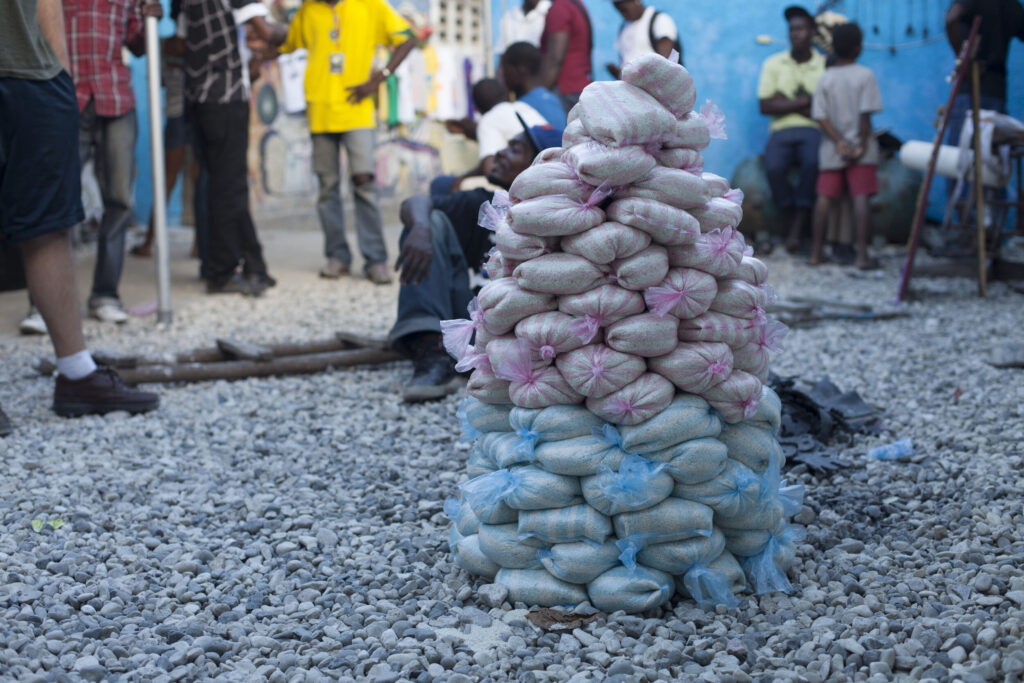
Monolith, performance/sculpture, Haitian grown rice, colored plastic bags, 2013. With Ryan Groendyk, Chery Jerry Reginald, Hughens Féquière, Joel Pierre and Laforèt Roselord. Photos by Lazaros. Installed on December 12th of 2013 at the Grand Rue, Port-au-Prince, as part of the 3rd Ghetto Biennale of Haiti.
Michele: What should people know about you when viewing your work?
Zé: I want people to know that I am not important for their experience of my work. In fact, I am quite irrelevant. There is nothing in my personal life, intentions, identity, or cultural background that matters to my work. My ideas may come from personal experiences, but the actual works of art are crafted as automatons, they move on their own, and speak for themselves regardless of my intentions. I want people to make sense of the work without me.
Michele: What is the most gratifying for you in the creation process?
Zé: The birth of an idea. Actually, I don’t have the habit of working in a dedicated space I could call a studio. When I want to fabricate things I usually go to the classrooms where I teach, or to the school workshops, as most materials and tools I need are already there. And I spend a lot of time in my home office, which is basically a desk with a computer on it, in my living room. That is where I plan and prepare for my projects, and also where I do video editing and other digital forms of work. But coming up with new ideas is what brings me the most joy, and I get my ideas anywhere, doing the most banal things like walking, doing the dishes, or exercising. In that sense, the whole world is my studio.
Michele: What role do artists play in shaping the future?
Ze: The greatest, and possibly the most important task for us artists, is to imagine the future, to regain the ability to imagine futures any different from the present or the immediate past. Mark Fisher was tragically right when he wrote, in Capitalist Realism, that the future had been cancelled sometime in the 1990s. Since then, we have been haunted by the past. This is obvious in contemporary music and film, stuck in a mode of perpetual nostalgia. Even sci-fi and fantasy have
a hard time imagining alternatives to the current state of things. We live in times of great conformity, in art and in politics. It’s a crisis of imagination. We’ve accepted that the current world is the best possible world. We’ve become unable to produce new cultural forms. We need to snap out of this paralysis in order to move forward. Artists have important roles to play in that.
Línguas de Fogo (Tongues OF Fire), 2024, a queer Amazonian comedy-horror. Shot in the Brazilian north in 2022
Michele: What organizations or individuals have supported you along the way?
Zé: I’ve had a lot of help from friends, teachers, and collaborators, as well as schools and art organizations. I owe a lot to my mother, who was very generous and patient as I finished my education in an area that didn´t promise great economic rewards. The Joinville Art Museum, in Brazil, was an important venue and supporter of my early trajectory, back in 2006. The city of Joinville then had a robust foundation for the arts, which offered yearly grants for artistic and curatorial projects. I learned a lot from those projects, and they put me on the radar for bigger things. I should mention my two times in graduate school, which had a big impact on my production. I studied in the State University of Santa Catarina, in Brazil, and then in Michigan State University. My years in Michigan taught me the basics of academic life in the USA, which allowed me to stay around and continue to do what I do. Most importantly, they funded my first visit to Haiti to participate on the Ghetto Biennale of 2013. That event was the most challenging, and important formative experience for me. I returned to Haiti in 2015, 2017, and 2019 for other editions of the biennale, and created some of my best work there. I am reluctant to start a list of people who helped me, because I don´t want to risk forgetting anyone. There were so many! You know who you are. Thank you.
Michele: What is your go to tool in your art practice toolbox?
Zé: Over the years I’ve become proficient with various tools and techniques, from drawing to digital cameras, which I use on an ad-hoc basis. But one that I´ve used consistently, since the 1990s, is the computer. It is essential to my practice. Every project starts out in front of a computer when I first write down the idea and begin planning its execution. And I return to the computer at the end of each project, to compile documentation, write about the work, promote it, etc. As soon as the internet and search engines were available, the computer also became my main research tool. Nowadays I get a lot of ideas from social media, especially YouTube.
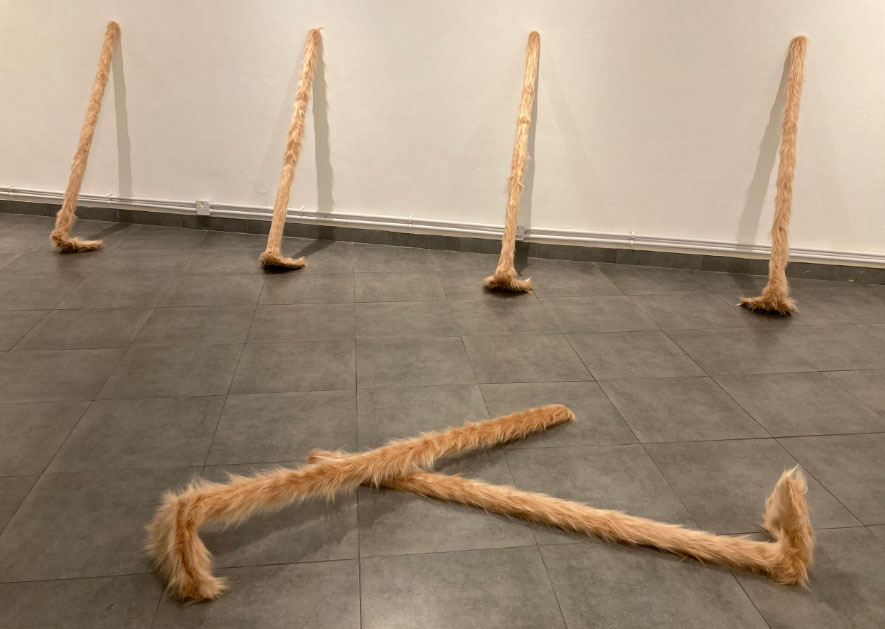
Zé Kielwagen, 2022, Artist Hoe, hoes covered in pink plush fabric, variable dimensions. Detail from Deflagração exhibit, held at Sala Edi Balod at UNESC (University of the Extreme South of Santa Catarina), in Criciúma, Brazil, in July of 2022. Curated by Maurício Bittencourt.
Michele: Have you ever had an amusing experience that had you consider how people interact with your work in the world?
Zé: Back in 2009 I had created the first version of the artist hoe, which was a regular farmer’s tool covered in pink plush fabric. It was displayed at a gallery first, as part of a group show. After the show I put the piece on display at the lobby of the local gay club, where it lived for about a year. When I went back there to pick it up, the club’s owner told me the piece had given his security workers a hard time. There had been a series of theft attempts, each time by a different patron of the club. One time the person was already out in the street, walking away with the hoe. The security person had to chase him to retrieve the piece. Maybe they were countryside gays, who worked with hoes for real, out on the fields? I will never know. Regardless, I found that quite amusing, and even flattering: to have my artwork stolen is so much better than being ignored.
Michele: So many in the art world wear different hats to fund their art practice. What are your thoughts and experiences on how artists support their life and work financially?
Zé: I worked as an illustrator and graphic designer in my 20s, and later transitioned to an academic career. I sell some artwork every now and then, but what really pays my bills is teaching. Unfortunately, art is not the most viable career for working-class people. No wonder they make fun of it! I wish we could talk about this more often, and more openly. Instead, the art world and its institutions, especially in the USA and Europe, mystify the problem. We try to conceal it.
We are quick to point out the privileges of patriarchy, white supremacy, cis-hetero normativity, and so on, and that is good, but we are not as willing to address the economic privilege that makes most “great” artists of our time, and of the last century. We insist on classist distinctions between arts and crafts, art and design, “pure” and “applied” arts… We idealize art as the purest pursuit of the human spirit, as if no artists had to deal with the contingencies of concrete and material reality. Being a working-class artist from Brazil, this was always evident to me. Having worked in Haiti, where life is harder than in Brazil, made this painfully clear. I am not at peace with this situation. I feel conflicted about it, and I hope whoever reads this feels conflicted too, so that maybe we can work out a different way, a better way to move forward.
Zé Kielwagen
Follow instagram.com/zekielwagen
View zekielwagen.art
Own zekielwagen.art/shop

